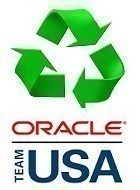Oracle yacht and Boeing 787 scrap create new recycling niche

Carving up a racing yacht for its carbon-fiber composites marks the latest efforts supported by Boeing to reuse the material that’s now found in everything from surfboards to jets.
In a process that presages the future of Boeing’s 787 Dreamliners when they finish their useful lives, the yacht is being recycled and may end up as a bunch of stand-up paddle boards.
 The yacht’s mast and its 12-foot- wide hull were chopped into 4-foot sections, some of which will be shipped to the University of Nottingham in England, where Boeing funds a project researching end uses for recycled carbon fiber of the type used in the 787s.
The yacht’s mast and its 12-foot- wide hull were chopped into 4-foot sections, some of which will be shipped to the University of Nottingham in England, where Boeing funds a project researching end uses for recycled carbon fiber of the type used in the 787s.
The rest went to MIT-RCF, a South Carolina carbon-fiber recycling facility.
“Six pallets of that cutup boat arrived last week and six more arrived today,” Mark Housley, executive vice president of sales for MIT-RCF, said Wednesday.
Fear not — this isn’t the amazingly cool catamaran that won the recent America’s Cup race for Oracle Team USA. Rather, it’s USA-71, a yacht that was originally built for the 2003 America’s Cup but never raced. It was used only as a trial boat and was later put on display outside Oracle’s headquarters in Redwood City, Calif.
“We’re talking to different vendors to find uses for the content,” said Chris Sitzenstock, logistics manager for the Oracle racing team. “We’re talking to Hobie and the guy who makes fins for wakeboards.”
Think Californian recreational water sports: Hobie makes stand-up paddle boards in San Juan Capistrano. The other “guy” that Sitzenstock referred to is hydrofoil-maker Skyski, of Redding, Calif.
The yacht being deconstructed has a state connection because of how its hull was fabricated: Epoxy-infused carbon-fiber tape is laid on top of a mold, then hardened by baking in a high-pressure oven.
The molds — precisely engineered to collapse inwardly for removal after the part emerges from the oven — were built by Janicki Industries, of Sedro-Woolley .
Janicki made these molds, known as mandrels, for all of Oracle’s America’s Cup yachts, including this year’s winner. Similar molds were used to build the rear fuselage sections of Boeing’s 787.
Sitzenstock said MIT-RCF’s recycling process begins with pyrolysis — heating the material to a high temperature in the absence of oxygen, a process that removes the resin without igniting the fibers.
 The salvaged fiber is chopped into short lengths that are used to make a slurry. MIT-RCF, which began operating at the end of 2010, forms and hardens this into relatively low-strength structures for such uses as water- recreation equipment, airplane-cabin interiors and automotive finishing.
The salvaged fiber is chopped into short lengths that are used to make a slurry. MIT-RCF, which began operating at the end of 2010, forms and hardens this into relatively low-strength structures for such uses as water- recreation equipment, airplane-cabin interiors and automotive finishing.
The Dreamliners flying today should have useful lives of around 25 to 30 years, maybe longer. So for now, the source of MIT-RCF’s carbon fiber is mostly the waste byproduct of composite manufacturing.
Boeing spokeswoman Jessica Kowal said the jet-maker is collaborating with Oracle to learn more about carbon-fiber-composite recycling.
“There is some market for recycled carbon fiber, but it’s not extensive,” said Kowal. “We’re trying to learn — what else can you do with it? It’s still a science project.”
“The long-term goal is closed-loop manufacturing,” she added. “To return composites from retired aircraft and from manufacturing scrap back into the aerospace supply chain.”
Today, some of Boeing’s 787 composite scrap goes into the garbage and ends up in landfills; some is used for research, including the work with the University of Nottingham; and some goes to MIT-RCF, which has sold it for use in products including “kayak paddles, car parts and electronics parts,” Kowal said.
In your next life, 787 Dreamliner, humans may stand upon your back and paddle the water.
Original story: Google News : Seattle Times (search terms : yacht )
![]()

Post your comment
You cannot post comments until you have logged in.
Login to post a commentComments
No one has commented on this page yet.
RSS feed for comments on this page | RSS feed for all comments